Missouri gooseberry
(Ribes missouriense)
Conservation • Description • Habitat • Ecology • Use • Distribution • Taxonomy
|
|
|||||||||||||
Description |
Missouri gooseberry is an erect shrub that rises on multiple stems from a branching, woody root system. The stems are ascending, arching, or prostrate on the ground and creeping (trailing), occasionally branching, and 24″ to 80″ long. Long stems may arch to the ground and root at the tip, forming a crown that sends up new stems. Other stems may be trailing and may root at the nodes. First year stems are green and hairy. They become grayish or whitish and hairless by the third year. The stems and branches have 1 to 3 well developed, straight, stout, ¼″ to 11 ⁄16″ long, reddish-brown spines just below the nodes, though these are sometimes absent. The stems also have straight, strong, slender, up to ¼″ long, brown bristles between the nodes. The branches have fewer bristles or no bristles between the nodes, especially near the top of the plant. The bristles are abundant on the lower ½ or ⅓ of the stem and on the larger branches, but are absent from the upper stem and smaller branches. The leaves are alternate and occur singly or in small clusters (fascicles) of 2 or 3. They are circular in outline, ⅝″ to 1 9 ⁄16″ long, and ¾″ to 1¾″ wide, and are on hairy, ¼″ to ¾″ long leaf stalks. The leaf blades are palmately divided into 3 or 5 lobes. The lobes may be further divided into 3 or 5 shallow secondary lobes. The base is usually tapered, rounded, or shallowly heart-shaped, sometimes squared off. The upper surface is green and nearly hairless. The lower surface is similar in color but moderately to densely covered with soft hairs. The margins are toothed with rounded teeth. The inflorescence is a solitary flower or a loose, unbranched cluster of 2 to 4, flowers drooping from a leaf fascicle on a slender, 1 3 ⁄16″ to 2″ long stalk (peduncle). Each flower is about ⅓″ long and droops downward on a slender, 3 ⁄16″ to ½″ long stalk (pedicel). There is a pair of bracts at the base of the pedicel. The bracts are 1 ⁄16″ to ⅛″ long, shorter than the flower stalks, and are fringed with hairs. At the base of the flower is a smooth, green ovary. Above the ovary is a smooth, greenish-white, narrowly tube-shaped, 1 ⁄32″ to ⅛″ long, cup-like structure (hypanthium). Neither the ovary nor the hypanthium have hairs or prickles on the surface. At the end of the hypanthium are 5 sepal lobes. The lobes are pale green to white, 3 ⁄16″ to ¼″ long, and initially erect but soon bending outwards or sharply backwards. The sepal lobes are longer than the calyx tube (the outer portion of the hypanthium). Also at the end of the hypanthium are 5 pale green to nearly white, inversely egg-shaped, 1 ⁄16″ to ⅛″ long petals. The petals are erect and converging, but not actually fused. They become pinkish with age. Emerging from the hypanthium are 5 stamens with cream-colored to pale pink anthers, and 2 styles. The stamens are 3 to 5 times as long as the petals. The filaments are 5 ⁄16″ to 7 ⁄16″ long and are fused for one-half to three-quarters of their length. The styles are 7 ⁄16″ to ⅝″ long, fused together for ⅞ of their length, and hairy at least near the base. The fruit is a globular, 5 ⁄16″ to 9 ⁄16″ in diameter berry. Immature berries are green with narrow, pale green, vertical stripes. When ripe they are dull red or dull purple. There are no prickles or hairs on the surface of the berry. Berries mature early mid-July to mid-August. |
Height |
24″ to 80″ |
Flower Color |
Pale green to white |
Similar Species |
Eastern prickly gooseberry (Ribes cynosbati) calyx lobes are shorter than the tube. The ovary is densely covered with stiff, gland-tipped hairs. The fruit is covered with stiff, broad-based prickles. Hairy-stem gooseberry(Ribes hirtellum) is a shorter plant, with stems no more than 60″ long. Spines at the node are poorly developed or absent. The sepal lobes, filaments, and styles are all much shorter. The sepal lobes are shorter than the calyx tube and are spreading or somewhat bent backward. The filaments are ⅛″ to 3 ⁄16″ long, extending only slightly beyond the petals. The styles are 3 ⁄16″ to 5 ⁄16″ long and are fused together for only half of their length. The plant is found throughout northern Minnesota and is absent from the south. |
Habitat |
Moderately moist to dry. Open woodlands, woodland borders, forested floodplains, thickets. Partial sun. |
Ecology |
Flowering |
Late April to early June |
Pests and Diseases |
|
Use |
|
Distribution |
||
|
Sources |
|
Nativity |
||
Native |
||
Occurrence |
||
Very common |
||
Taxonomy |
|
Kingdom |
|
Division |
Tracheophyta (Vascular Plants) |
Subdivision |
Spermatophytina (Seed Plants) |
Class |
|
Superorder |
Saxifraganae |
Order |
Saxifragales (saxifrages, stonecrops, and allies) |
Family |
Grossulariaceae (gooseberry) |
Genus |
Ribes (currants and gooseberries) |
Subgenus |
Grossularia |
Section |
Grossularia |
Subordinate Taxa |
|
|
|
Synonyms |
|
Grossularia missouriensis Ribes missouriense var. ozarkanum |
|
Common Names |
|
Missouri gooseberry |
|
Glossary
Bract
Modified leaf at the base of a flower stalk, flower cluster, or inflorescence.
Calyx
The flower cup. May be the group of outer floral leaves (sepals) collectively, or a tube with lobes.
Fascicle
A small bundle or cluster, often sheathed at the base, as with pine needles.
Hypanthium
A cup-like tubular structure of a flower formed from the fused bases of sepals, petals, and stamens, that surrounds the pistil. Its presence is diagnostic of many families, including Rose, Gooseberry, and Pea.
Node
The small swelling of the stem from which one or more leaves, branches, or buds originate.
Palmate
Similar to a hand. Having more than three lobes or leaflets that radiate from a single point at the base of the leaf.
Pedicel
On plants: the stalk of a single flower in a cluster of flowers. On insects: the second segment of the antennae. On Hymenoptera and Araneae: the narrow stalk connecting the thorax to the abdomen: the preferred term is petiole.
Peduncle
The stalk of a single flower or flower cluster.
Sepal
An outer floral leaf, usually green but sometimes colored, at the base of a flower.
Stamen
The male reproductive organ of a flower consisting of an pollen-producing anther on a supporting filament.
Trailing
Prostrate on the ground and creeping.
Visitor Photos |
||
Share your photo of this plant. |
||
This button not working for you? |
||
Greg Watson |
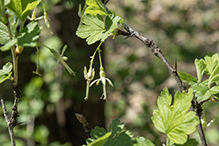 |
MinnesotaSeasons.com Photos |
||
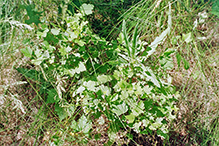 |
 |
|
Plant |
||
|
||
|
||
Plant |
||
 |
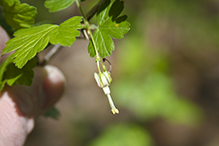 |
|
Inflorescence |
Flower |
|
 |
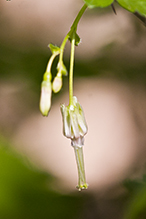 |
|
Flower |
Flower | |
 |
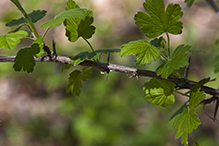 |
|
Upper stem |
Upper stem | |
 |
 |
|
Leaves |
||
|
||
|
||
Lower stem |
||
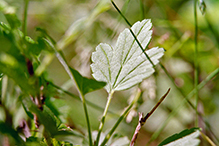 |
 |
|
Leaf |
Leaf |
|
 |
 |
|
Fruit |
Fruit |
|
 |
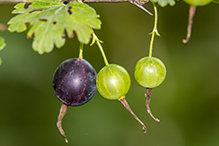 |
|
Fruit |
Fruit |

Slideshows |
|

Visitor Videos |
||
Share your video of this plant. |
||
This button not working for you? |
||
|
Other Videos |
||
Wild Gooseberry |
About
Published on Sep 11, 2012 No description available. |

Visitor Sightings |
||
Report a sighting of this plant. |
||
This button not working for you? |
||
Greg Watson |
Location: Eagles Bluff Park, La Crescent, MN |
 |
MinnesotaSeasons.com Sightings |
||

|
Created: 6/17/2006 Last Updated: © MinnesotaSeasons.com. All rights reserved. |
